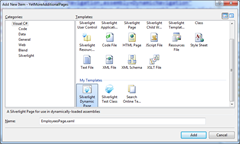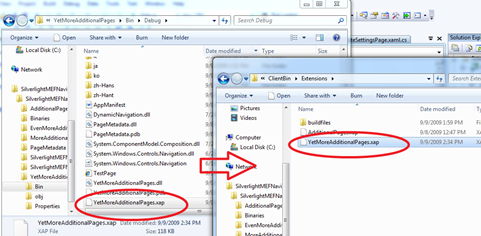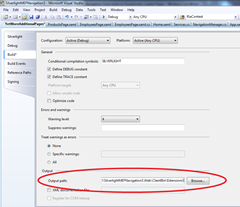Silverlight 3 Navigation: Even more on Dynamically Loaded Pages
I got a lot of great feedback on my post Silverlight 3 Navigation: Dynamically Loaded Pages… Now MEF Powered!
Dinesh Chandnani decided to do an update to this sample after looking at the feedback and talking to Nikhil Kothari and Wes Haggard from the MEF dev team. The goals for this update are:
- Show even more of a web like user model. With the web, you often see all the links in the navigation, but the actual page only downloads once the user clicked the link.
- Lose coupling. I need to be able to be able dynamically add, update even remove pages from my application without taking down the app and without rebuilding it.
- Built in authentication. In real business apps, we need to protect our data, so authentication is very important. The web has popularized a very interesting model where you are only asked to authentication when you try to do an operation that needs it. For example, i can browse the netflx catalog any time, but I have to log in the minute I try to add something to my queue.
Download the all the source code
Basic Authentication and User Settings
Let’s do a quick run through of what the app does (with no extensions just yet).
As you can see, it is the basic Silverlight Business Application template with Home and About pages that you can navigate to. As well as a log in button. But also notice there is a User Settings page who’s link is red which indicates the user needs to log in to see the contents of the page. So if I log in as a user (Login: guest Password: guest**)
I am now logged in and can access the Site Settings page, so it is no longer red.
On this page, I can edit user level customization of the app. In this case, the background color of this page. This data is stored on the server is the ASP.NET profile store, so each user can have their own settings that will work on any machine they go to.
To bring that point home, let’s go in and create a new user, and give that user a different background color.
Click on login
then Register Now
I registered “guest3”..
Now, i set the background color to be yellow
Then I log out and log in as guest and it is back to red.
Oh, and what is even more cool, is if you haven’t noticed yet, if you are not logged in, and you click on a link that requires authentication, you are prompted to log in and then the page is shown to you! Very web like.
Loading Extensions
Ok – that is cool and all, but this is a MEF blog post, so we have to talk about application extensibility right? The scenario here is that you are building a composite applications that may have many possible pages. The pages that are there are available maybe very dynamic… it may depend on who the logged in user is, in a multi-tenant environment it may depend on the service level of the client, it may also depend on what has been developed yet. In all those cases, we don’t want to rebuild the app each time there is a new extension, in fact we don’t even want to take the app out of production. We’d like to simply xcopy the AdditionalPages.xap extension into a directory and instantly the right clients have access.
Simply hitting refresh on the application makes two new pages show up “products” and “site settings”
Clicking on the “products” link causes the AdditionalPages.xap to be downloaded.
Once the xap is downloaded the page displays
Once the xap is downloaded users can navigate between the pages with no delay.
As an aside, this xap also includes a page that only an admin can access. So if you log in as a user, you still can’t access it.
Not logged in at all, you can’t access user or site wide settings
Logged in as a guest, you can access only user settings
Logged in as admin, you can access both site and user settings
Communicating Between Exceptions
What we have shown so far is loading of isolated pages dynamically.. while that is very cool, what is more interesting is where these pages have to interact together. For example, sharing data between pages. As you might guess, MEF has a model that fits in very nicely here.
If you check out the products page, it actually has access to information about the currently logged on user.
It gets this information from the main silverlight application via an import. In products.xaml.cs, we are importing the RiaContext (which includes information about who is logged in).
1: [Import]
2: public RiaContextBase RiaContext
3: {
4: get { ... }
5: set { ... }
6: }
and in the Silverlight application, in Services.cs we are exporting the RiaContext which is populated from the server.
1: public static class Services
2: {
3: [Export]
4: public static RiaContextBase RiaContext
5: {
6: get { ... }
7: }
8: }
When the xap gets downloaded to the client, these exports and imports are resolved. Using this model any pages can share state.
Adding Additional Pages
What is very cool about this model is how easy it is to add additional pages.
1. Add a new SilverlightApplication
Remove the test page…
Remove MainPage.xaml and App.xaml..
Add References
DynamicNavigation - David Poll’s Navigation Extension
System.ComponentModel.Composition – MEF
System.Windows.Controls.Navigation
System.Windows.Ria
and add a project reference to PageMetadata
1: namespace YetMoreAdditionalPages
2: {
3: [PageContent(Name="employees")]
4: public partial class EmployeesPage : DynamicPage
Now build, and then copy the YetMorePages.xap over to the extensions directory.
Hitting F5, now we have our page dynamically loaded!
If you are doing active development, i’d suggest setting the build output directory of the extensions to the extensions directory. This avoids the explicit copy step each time.
Summary
In this example we looked at how to build an authentication aware, composite silverlight application… you can download the all the source code ..
Comments
Anonymous
September 10, 2009
Is the download correct, I can't find a login?Anonymous
September 10, 2009
Hmm.. it seems to work for me, there should not be a log in required.Anonymous
September 10, 2009
Same thing here. I downloaded twice.. Using link at top and bottom of article. Dynamicloading stuff is there but I don't see the same thing you are showing in the article. No LogIn link or Site Settings link.Anonymous
September 10, 2009
Ahh -- bad day for me... sorry... I had the wrong link up there... should work now. thanks for letting me know..Anonymous
September 10, 2009
1 quick thing - the credentials for the admin for this sample is: Login: admin Password: admin** Brad already mentioned above that the credentials for guest is: Login: guest Password: guest** Cheers!Anonymous
September 16, 2009
The comment has been removedAnonymous
September 19, 2009
I attached the database but what is the connection string for this.Anonymous
September 21, 2009
I would like to see a sample of logging into an .aspx page and have that shared with Silverlight... or Logging into Silverlight and have it share with .aspx. Since Silverlight runs in a page in a website. This situation of having a mix of .aspx/AJAX and Silverlight work together is important. Do we have to login, for each environement even on the same site?Anonymous
September 21, 2009
Would also like to see a sample of a navigation menu that is stored in a database. Menu item access is associated with roles and thus access can be changed without changing code. The SQL select would only return menu items that the user has access to.Anonymous
September 28, 2009
Very nice app. Does the time thats required to download the XAP files depends on file size ? If so how can we make that as faster download ? Thanks, ThaniAnonymous
October 06, 2009
When I try to use this: HttpContextWrapper httpContext = this.ServiceContext.GetService(typeof(HttpContextBase)) as HttpContextWrapper; Inside a LinqToEntitiesDomainService, I get the error: This DomainService has not been initialized. I can't see how you setup the DomainService differently than what RIA generates for this to work. Thanks...Anonymous
October 18, 2009
The comment has been removedAnonymous
November 10, 2009
Great article indeed but why source code is no longer available?! All links are broken :(Anonymous
November 10, 2009
sorry, my site was down, seems to work nowAnonymous
November 22, 2009
Hi there .. Great article indeed but I am having some problems I already have aspnetdb in my SQL Server but where is the connection string for this so i can connect it qith my localhost. And wht is this RAI can you please tell me.























